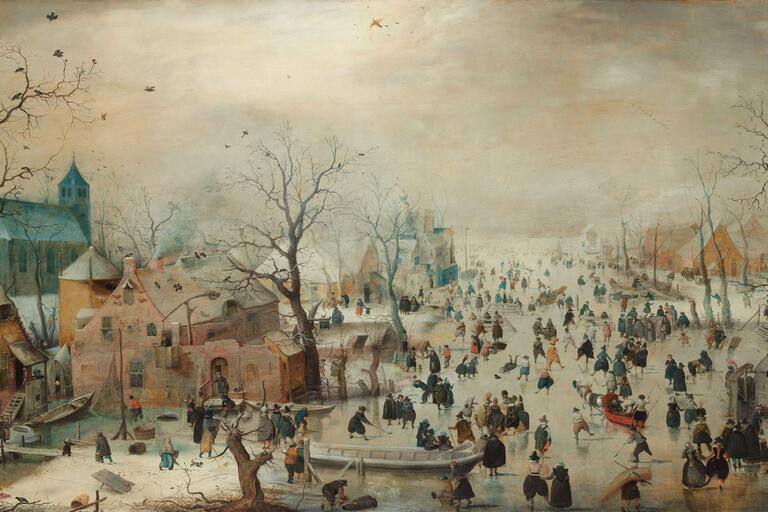Monday, June 21
10:00 AM - 12:00 PM
Climate and History: An Introduction
Sam White
This presentation will explain how experts reconstruct climate variations and extreme weather in past centuries. We’ll explore some results of those reconstructions, how those past changes compare to present global warming, and what they might mean for human history during the Little Ice Age.
Tuesday, June 22
10:00 AM - 12:00 PM
The History of Climate and Society: Challenges, New Approaches, and Significance
Dagomar Degroot
Global warming today poses unprecedented challenges, yet Earth’s climate has repeatedly changed over the 300,000-year history of humanity. For over a century, scholars have sought to uncover how these changes influenced human populations, a field of study recently coined the “History of Climate and Society” (HCS). This talk describes the most important findings of HCS scholarship, which has largely focused on past disasters. It then introduces a new approach to HCS that is helping scholars uncover how some populations prospered amid past climate changes – with lessons for our hotter future.
How to See Water in an Age of Unusual Droughts: Ecological Aesthetics in the Little Ice Age, India
Sugata Ray
The Little Ice Age (ca. 1550–1850), a climatic period marked by glacial expansion in Europe, brought droughts of unprecedented intensity to South Asia. In drought-ravaged north India, the beginnings of the Little Ice Age not only corresponded with the emergence of new techniques of landscape painting and riparian architecture that emphasized the materiality of flowing water but also saw the enunciation of a new theology of Krishna worship that centralized the veneration of the natural environment. Tracing the intersections among artistic practices, theological economies, and the ecocatastrophes of the Little Ice Age, this talk aims to generate an ideation of an eco art history that brings together the environmental and the aesthetic.
Wednesday, June 23
10:00 AM - 12:00 PM
The Little Ice Age in Seventeenth Century China
Clark Alejandrino
How did the coldest years of the Little Ice Age impact the fortunes of the Ming and the Qing empires and their peoples? We will look at how climatologists and historians have answered this question. In the process, we will reflect on questions of historical causation and human agency, which are relevant to discussions of climate history and climate change.
Colonialism and Climate: Agroecological Ingenuity in the Tlaxcalan Little Ice Age
Lucy Gill
From the 1540s-1700s, just as Indigenous communities of Mexico were suffering from violence and disease wrought by Spanish colonial rule, rainfall and cloud cover in Central Mexico increased, while temperatures plummeted. The coincident timing of these anthropogenic and climatic disturbances, and their ensuing effects -- most notably, flooding, wetland siltation, and soil erosion -- forced Indigenous farmers to respond creatively to these challenges. Through new engagements with American and European flora and fauna and extensive environmental engineering, Tlaxcalans were largely able to avert ecological degradation, until a new agrarian regime characterized by monoculture emerged in the 18th century left the ecosystem more susceptible to climatic fluctuation.
Thursday, June 24
10:00 AM - 12:00 PM
The Little Ice Age in southeast and west-central Africa: variability, impacts, responses
Matthew Hannaford
This talk will examine historical documentary and palaeoclimate evidence on the Little Ice Age in southeast and west-central Africa, 1550-1830. First, it will compare the characteristics of the Little Ice Age using these two forms of evidence and consider the drivers behind observed patterns in rainfall variability. Second, it will examine the human impacts of, and responses to, multi-year droughts across this time period. Particular attention is given to divergent impacts and responses between colonial society on the Zambezi river and its African neighbours, with emphasis placed on agricultural systems and institutions.
Friday, June 25
10:00 AM - 12:00 PM
Tambora and The Year Without a Summer, 1816
Gillen D'Arcy Wood
What happens when the world’s climate reaches a sudden tipping point?
2016 marked the 200th anniversary of the so-called “Year Without a Summer,” 1816, spawned by fallout from the massive eruption of Mount Tambora in Indonesia. During that global climate emergency, volcanic conditions disrupted monsoons in India that contributed to a devastating new strain of cholera, while crop failure and famine crippled nations from China to Western Europe to New England, precipitating food riots and the mass emigration of refugees. The extreme weather crisis also made waves in the world of art and literature, with Mary Shelley’s Frankenstein the most notable work of imagination to emerge from “The Year Without a Summer.”
This talk, based on Wood’s award-winning Tambora: The Eruption that Changed the World—the first book to present a comprehensive investigation of the environmental calamity of 1816—provides a gripping disaster narrative, with important lessons not only for scientists, historians, educators and students, but also local communities and governments tasked with responding to today’s climate crisis.

